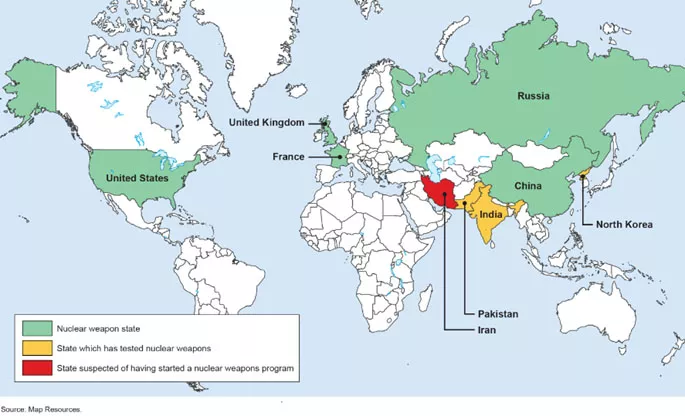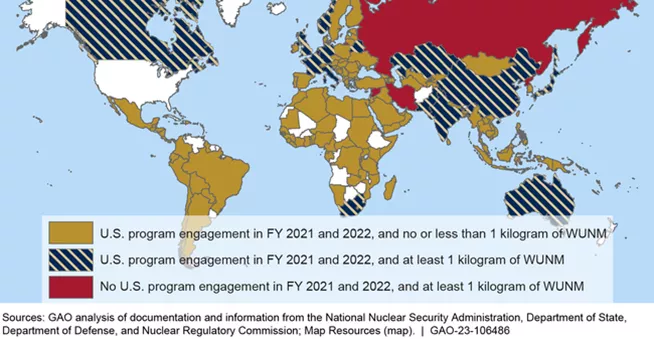International Nuclear Security
Issue Summary
Since the 1960s, the United States and other nations have sustained a nuclear nonproliferation regime to curb the global spread of nuclear weapons. This has helped facilitate nuclear commerce and peaceful nuclear material and technology uses, while constraining significant growth in the number of nuclear weapon states. At the same time, the United States and Russia have implemented a range of arms control treaties and agreements that have dramatically reduced the size of nuclear arsenals and lessened nuclear dangers.
Countries with Nuclear Weapons, that have Tested Nuclear Weapons, or Are Suspected of Pursuing Nuclear Weapons
Image

However, the United States and other nations face a number of enduring and evolving nuclear proliferation threats that could undermine this status quo and jeopardize international security and stability. These threats include inadequately secured weapon-usable nuclear materials in regions of concern, terrorists potentially acquiring nuclear weapons, and nuclear weapons programs in countries of concern (such as North Korea). In addition, prospects for a future U.S.-Russian nuclear weapons reduction treaty have dimmed as the bilateral relationship has worsened in recent years, making it more difficult for the United States to monitor and verify developments in Russian nuclear forces.
Federal agencies, including the National Nuclear Security Administration (NNSA) and the State Department, as well as international organizations like the International Atomic Energy Agency (IAEA)—an independent international organization affiliated with the United Nations—work on reducing such threats and curbing nuclear proliferation. .
U.S. Program Efforts to Secure Nuclear Materials, including Weapon Usable Nuclear Material (WUNM), FYs 2021 and 2022
Image

However, these organizations face a number of challenges.
For instance:
- International security. NNSA works to secure and minimize weapon-usable nuclear materials worldwide, support the development of technologies to detect nuclear proliferation, and dispose of excess nuclear materials (among other things). NNSA has completed a number of projects to upgrade security at dozens of Russian nuclear material sites, such as installing modern perimeter fencing, surveillance cameras, and equipment to track and account for nuclear material. However, this work was incomplete and curtailed when Russia invaded Ukrainian territory, in the Donbas and Crimea, in 2014. Today, little is known about security at these sites, including the extent to which Russia has maintained U.S.-funded improvements. Additionally, NNSA and other U.S. agency programs working to address nuclear material security risks in other countries around the world must deal with a number of trends that could exacerbate these risks—such as advancements in cyber capabilities.
- Building consensus. The State Department works to sustain international consensus on nuclear nonproliferation, coordinates implementation of international treaties and agreements, and manages cooperative nonproliferation programs and activities. For example, it leads negotiations for U.S. nuclear cooperation agreements. These agreements outline conditions—such as physical security and peaceful use—for partner countries that are allowed to import civilian nuclear material and equipment from the United States. In negotiating these agreements, the United States has also expected partner countries to accept other conditions, such as agreeing to not to establish uranium enrichment programs. However, some countries with which the State Department has been negotiating agreements have been reluctant to accept such conditions.
- Stabilizing funding. The U.S. works with the IAEA to ensure that nuclear materials and activities around the world intended for peaceful purposes are not diverted to weapons, and that nuclear and radiological materials and facilities are adequately protected. For example, the IAEA’s safeguards program helped monitor and verify certain provisions in the 2015 nuclear agreement with Iran, through which Iran committed to limits on its nuclear program in exchange for relief from sanctions. However, the IAEA faces a range of challenges to the effective and efficient implementation of its safeguards program—such as new types of nuclear facilities that may require new monitoring methods. In addition, the IAEA could improve reporting on the results of its efforts to improve nuclear security worldwide. IAEA also relies heavily on voluntary contributions and hasn’t analyzed ways to stabilize its nuclear security funding. The State Department (which coordinates U.S. policy with and financial contributions to the IAEA) could help it address these issues.

